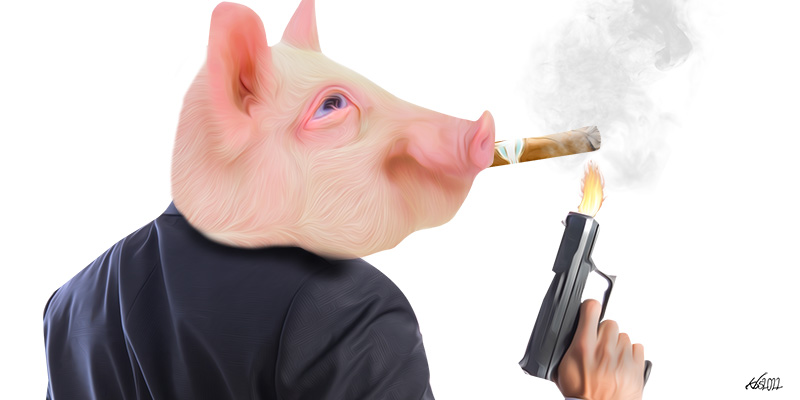Nobody should really be surprised by the conflict taking place inside the Republic of Ukraine. In their long modern history, Europeans have been at war, or in preparation for war, or recovering from one, longer than they have been at peace.
Western Europe has been the key driver of conflicts at home and globally for the last three centuries. European armies have war graves in just about every country on every continent.
The only surprise is that they have been able to keep their warlike behaviour in check for the last seventy-seven years (if we exclude the fighting that followed the 1990 break-up of Yugoslavia), since the end of their 1939-1945 war that they spread to much of the rest of the world.
And even that peace was only because they managed, for once, to come to an agreement about the thing that drives their conflicts: money.
Ambassador Martin Kimani, Kenya’s permanent representative to the United Nations did an important thing when he asserted the idea that Africans can also have an opinion on world events, drawing on the lived African historical experience.
In his February speech to the Security Council, while criticizing the then anticipated Russian military entry into Ukrainian territory, Ambassador Kimani urged Russian leaders to follow the example set by Africa’s post-colonial leaders and simply accept post-empire borders as they are. He also urged them to put their faith in international diplomacy, in order to resolve such disputes.
Deep down, these words will sound strange to European ears on all sides of the Ukraine dispute. The historical record shows that this is simply not how these people do business, and certainly not the white powers of Western Europe (which birthed other white powers like the United States and Canada). For them, war is the norm, and when they say “peace”, they mean their successful imposition of conditions to their liking on the side they have defeated.
Ambassador Kimani urged Russian leaders to follow the example set by Africa’s post-colonial leaders and simply accept post-empire borders as they are.
The conflict now located in Ukraine has been brewing for quite some time. It is an expression of a wider tension between the continuing ambitions of Western countries and economic masters against the interests of Russia in the various forms it has taken before, during and after becoming the world’s first, biggest and most powerful non-capitalist state.
There has never been a period of actual good relations between Russia and the Western European powers in over one hundred years. And places like Ukraine are where this has often played out. The great plains of Europe, lying between Russia proper and the powers of the West, made up of shifting, weaker states, have always been a buffer zone.
In the first phase, this was the fight between the German and Russian empires during the 1914-1918 war, which led to both the collapse of the Russian monarchy, and the dissolution of the German Empire.
The second phase was between 1920 and 1939, when various combinations of Western European powers sponsored rebellions, small wars and sabotage in an attempt to dislodge the communist-led Union of Soviet Socialist Republics (USSR) regime that had eventually taken over the Russian state following the collapse of the monarchy there.
This was only briefly suspended by the rise of fascism to state power in Spain, Italy and Germany, setting the conditions for the 1939-1945 war.
But this was in fact a war against Germany’s attempt to re-establish an empire to replace the one taken from it under the terms of the treaty ending the 1914-1918 war, much as it was dressed up as a war against the fascism of Hitler’s Germany. During that war, the capitalist Western powers were embarrassed to have had to make an anti-Hitler alliance with the very Soviet Union they had been trying to undermine militarily not a few years earlier.
There has never been a period of actual good relations between Russia and the Western European powers in over one hundred years.
The end of that war gave rise to the third phase, between 1946 and 1991, when the effort to remove the communists (whose reach had now expanded to control parts of central Europe) resumed and became an all-consuming fixation of Western statecraft. Now led by the United States, it re-oriented all Western political, diplomatic and military thinking to see the Soviet Union, and its satellites state, as the principal enemy.
It is in this phase, known as the Cold War, that institutions like the US-dominated military alliance known as the North Atlantic Treaty Organization (NATO: 1947), the well-known American Central Intelligence Agency (CIA: 1947) in the West, and the rival Soviet-led Warsaw Pact (Treaty of Friendship, Co-operation and Mutual Assistance: 1955) in Eastern Europe, were formed. This phase officially came to an end with the collapse and dissolution of the USSR in 1991. The Warsaw Pact dissolved in 1991 while, conversely, NATO has just kept on going.
Originally made up of 15 member states by 1955, and committed to mutual defence for fifty years, NATO has never properly explained why then it continues to exist. There are a number of contradictions. The Cold War itself did not last 50 years, and the NATO side won anyway, yet it has gone on to include fifteen new members, thus doubling its membership. What is more, the bulk of these new member states are former territories of the Warsaw Pact, with membership being offered to even more, such as Ukraine, which used to be part of the Soviet Union proper. In other words, NATO became twice as big as its original size after the reason for its creation no longer existed.
This brings us to the fifth phase running from 1991 to Russia’s February invasion of Ukraine, which is a whole story in itself.
Russia’s unease with this expansion—expressed in a number of failed diplomatic initiatives, with Ukraine increasingly at the epicentre—was never really taken seriously. The immediate trigger begins with a 2014 coup in Ukraine that brings a pro-West government to power. There followed a series of measures against the Russian ethnic minority of Ukraine, as well as proscriptions against the symbols and legacy (both good and bad) Russia had left in Ukraine during the communist era. In particular, there was the public rehabilitation of the legacies of fascist organizations that had collaborated with Hitler’s forces during the German invasions of the 1940s, and the public tolerance of new fascist organisations. It is one issue to wonder why anyone should find it desirable to join a political identity with such a record. It is another issue to also question why such politics should be even permissible in a society claiming to be civilized.
How this invasion ends will be the start, and then the nature, of the sixth phase.
Africans are not obliged to take sides. But there is a human obligation to share knowledge and experience, as Ambassador Kimani has done. And any call for the avoidance of armed conflict is a good thing.
More than once in the last century, Europeans have dragged us into their conflicts in a bout of global racism.
Therefore, scenes of Africans being discriminated against on the Ukraine-Poland border as they tried—like many other peoples in Ukraine—to flee the looming conflict, should have been expected.
European culture is racist, and it did not become racist when it arrived in the Americas, Asia and Africa; it was its racism that took it there in the first place. What is more, Europeans actually began their racism among themselves.
Eastern Europe is Slavic country. “Slavic” is how the Eurasian people described themselves, as a concept of praise. However, these people had been conquered in the 9th Century (in other words, in yet another inter-European war), and had been reduced to what would now be called slavery.
So, Western European history ascribed a different meaning to the name. “Slavonic” was turned to mean “captive” in Latin. “Slav” is where the word “slave” in Western European languages comes from.
European racism—now directed at mainly non-white people—may be less expressive and performative at home as compared to the settler spaces it created overseas, because it is less directly in the presence of black people, and it is also more secure and confident in itself at home. But it is always there; it is just a matter of opportunity and circumstance (such as a border).
The Nazi Germany era was in many ways a condensed form of the already 400-year white supremacist project that had seen white Europeans forcibly settle themselves in the Americas from the arctic to the Antarctic, Australia, New Zealand, and all of southern Africa. In all cases, these incursions (that Hitler called “lebensraum”, literally, “space for living in”, when he applied them to Eastern Europe) began with genocides, and were sustained on them.
European culture is racist, and it did not become racist when it arrived in the Americas, Asia and Africa.
Being hemmed in militarily, Hitler’s Germany found it necessary to massively mobilize its population. It did this by appealing to their racism by victimizing a significant minority in an acute intensification of perhaps the longest standing racial prejudice in European public life; vilifying people of Jewish descent, as well as picking on its neighbours.
Underneath the usual romanticisation of the conflicts among Europeans lies the story of coal and iron. Until perhaps the 1960s, the Alsace-Lorraine region, which lies where the lands of France and Germany meet, held the largest known deposits of iron ore in the Western world. Together with the abundant supplies of the coal in the neighbouring regions, this created the opportunity for the bulk production of perhaps the most significant material to industrialization—steel.
On top of the already mentioned 1914-1918 British-German war that led to Germany’s loss of its entire global empire as well as territory closer to home, and the 1939-1945 British-French-American-Russian war against Germany, Italy, and Japan, which left Europe militarily split in half for the following four decades, there had already been the Franco-Prussian war of 1870-1871 which had ended with German occupation of France. All these were essentially conflicts over the Alsace–Lorraine region.
It was the site of the beginnings of a reversal of fortunes for Germany in its big gamble to also invade the Soviet Union in 1941. This gave rise to the heroic politics of the Americans leading the massive landings on the shores of Western Europe in a race for Berlin, the German capital. The real panic was to try and capture Germany before the Russians advancing from the East did. Perhaps they feared that Russia would reclaim those territories it conceded to Germany as part of the process of pulling out of the 1914-1918 war in which the then new communist regime had felt it had no side.
Underneath the usual romanticisation of the conflicts among Europeans lies the story of coal and iron.
This is why from the day of the German defeat in 1945, up until its reunification in 1990, all the countries that had fought Hitler’s armies had their armies in the ridiculous situation of each controlling a cramped sector of Germany’s capital Berlin, while Berlin as a whole was itself deep inside Soviet-controlled territory (because the Soviet Union’s Red Army had overrun German territory before the Western armies got there).
Russia has always been governed by a cultural tension between its actual Asiatic roots, and an underlying tendency to embrace a more western European identity. This “Westernizer tendency” (as it is known) played a role in taking the monarchy to the degree of crisis the Russian Empire had. In trying to become more like the more industrialised powers to the west, Imperial Russia had become financially indebted to them.
The socialist revolution under the communist party put an end to this, and in so doing saved the Russian state from collapse.
All foreign investments as well as locally owned private concerns were nationalized. Furthermore, key elements of Slavic culture, such as language, were synthetized into education and science in a way that allowed for the rapid progress of the spread of education and technological knowledge. This enabled the country to make a rapid leap forward technologically, and become an industrial and military power by the middle of the last century.
The political leaders were also adept at keeping the country’s enemies at bay through military and diplomatic manoeuvring. The coming to power of the Russian communists in October 1917 only intensified this, because under the Russian monarchy, Russia had been in alliance with the big powers of the West (France and Britain), in fighting Germany in the 1914-1918 war. It was of great use partly because, being to the east of Germany, Russia formed a whole other front. Those powers were very annoyed when Russia’s new rulers pulled out of the conflict.
Russia has always been governed by a cultural tension between its actual Asiatic roots, and an underlying tendency to embrace a more western European identity.
From that moment, the fight was no longer over the respective profit-seeking factions of several empire states seeking to grab valuable territory and markets for themselves. It became a fight between all such factions collectively on the one side, versus a huge country taken over by a political party that was opposed to private profit-making to begin with, on the other.
But with this loss of a crucial ally in the ongoing war, three things were at stake for the powers to the west. Germany, which had only really united as one nation in the 1871 war (minus Austria; that would be organized later by Hitler), now had more opportunities and room to manoeuvre in the conduct of the war. There was the immediate possibility of Germany taking over all the installations and resources that the Russian forces had left scattered all over the eastern front from Finland, Siberia to the central European plains.
Second, the substantial aforementioned economic and war debts that the economic powers to the west had over broke imperial Russia were now under threat of not been honoured.
Finally, the prospect of the communist party finally taking power, especially in a major country, raised the prospect of communism (by this time a movement with nearly eighty years of struggle behind it) gaining popularity in all the major capitals of Europe. For (mainly Western European) capitalist governments, this would be a political disaster.
Germany lost the war anyway. And, as said, the big powers to the west immediately turned their attention to supporting a combination of Russian forces trying to remove the communists from power in a growing Russian civil war between 1920 and 1922. Eventually, after deploying a few military expeditions, and even engineering a couple of coup attempts, they gave up and went home. But they were to continue sponsoring Russian exile groups in sporadic incursions and attacks on the growing communist state for many years after, until 1939 when Britain and the United States, principally, needed to make an about-turn and form an alliance with the very same Soviet Union they had been undermining, against Hitler.
It paid off well; the record shows that Nazi Germany’s decisive defeat took place on the Eastern front, at great human and material cost to the Soviet Union. Russian losses to Nazi Germany exceeded 26 million people, including 10 million soldiers.
Therefore, beyond the earlier historic rivalries, by 1945 significant countries of Western Europe were collectively hostile to the Soviet Union, the culmination of a process that had begun shortly after the communist takeover of power in 1917, but which also predated it.
Indeed, as soon as the ’39-’45 hostilities ended in Europe with the capture of Berlin, the Western powers immediately reverted to a stance of armed hostility towards the Soviet Union. It is said that one legendary American General called Patton had to be removed from command because he was calling for an immediate attack on the Soviet forces in Germany, followed by the invasion of Moscow. This stance has effectively continued even after the demise of communist rule in Russia. The old game of lusting after the territories of the Balkans and beyond has resumed.
This then, is the Russian experience of Western powers, right from the start of the last century, whether as the Russian Empire, the communist state, or as the Russian Federation.
After being besieged by Western debt, what began as a free-for-all among the competing ambitious ruling classes of the various European empires developed into a quasi-unity of those ruling classes in a joint attempt to prevent the spread of communism among the ordinary people. Once that was achieved, they all went back to trying to have economic advantage over the weaker parts Europe. These were the 1990s wars over the re-division of the Baltic states, and their seduction into the Western debt-based economic system.
Whether democratic or not, any Russian head of state would do well to understand NATO’s interest in Eastern European countries now bordering Russia in this context. President Vladimir Putin, whatever one may think of him, certainly holds a sense of this history.
The old game of lusting after the territories of the Balkans and beyond has resumed.
Russia fears it may be seen as the next prize; the very name “Ukraine” literally means “border” or “frontier” in some Slavic languages. The only new development is that wealthy Russians probably also harbour the same ambitions, and wish to expand their own place in the Russian economy.
All this tells us Africans four critical things.
First, that these wars are about business: making money, or seizing territory to make money from it later. When capitalists want something, they find an excuse to start a war in order to get it. These recurrent conflicts were only suspended for the last eighty years with the creation of a trade mechanism that enabled interested European countries to access resources for their domestic industries without having to also physically control the territory. This mechanism began life as the European Coal and Steel Commission, later renamed the European Economic Commission, and then renamed again the European Commission. Today, it is known as the European Union.
To Europeans, fighting is normal. And they are very good at it, on the whole. They manufacture their own weapons, and make money out of that, too. War, for the European, is a relatively sustainable activity.
Even modest-sized European cities will have a monument (if not whole cemeteries) to the dead of more than one war. There are about 68,000 war memorials in the UK alone, and 3,000 war cemeteries in France.
Tiny Belgium holds about 800 military cemeteries for the 1914-1918, and the 1939-1945 wars alone. It is why military-style language (e.g. “to pull a flanker”, and “to steal a march”, in common English) peppers a lot of casual Western speech. It is why most Western armed forces retain standing divisions trained to be quickly transported far abroad, and to fight in terrain very unlike their home territories. Europeans (and white America) are warmongers. That is the historical and contemporary record, quite contrary to the political propaganda they produce in their media and education systems.
The second lesson is that among white powers (of which the Russian state is one) there is never any real principle involved. Millions died fighting “Nazis”, only for the politicians that sent them to their deaths to recruit those very same Nazi leaders into their own programmes.
When capitalists want something, they find an excuse to start a war in order to get it.
For example, one Arthur L. Rudolph was a German Nazi-era scientist brought to the United States in 1945 for his rocket-making expertise. He has even been honoured by the United States National Aeronautic and Space Agency (NASA). He is considered to be the “father” of the Saturn V rocket upon which the Apollo moon-landing programme depended.
More directly, one Adolf Heusinger, a German general who served as chairman of the NATO Military Committee from 1961 to 1964, had in an earlier life been a colonel in Hitler’s General Staff, and had been directly involved in planning the invasion of the Soviet Union.
The Soviet Union also grabbed from defeated Germany as many Nazi scientists as it could lay its hands on. But their case was handled more like a reparative abduction than the offer of an entirely new comfortable life.
Today’s enemy may become tomorrow’s friend, and today’s friend was the enemy yesterday. It is just their culture of politics, war and diplomacy. Get involved at your own risk.
Third, that when these giants fight, they do so on an industrial scale. Their conflicts often spill across other borders and territories. Their weaponry brings mass death, and their logistical and human resource needs often suck in people who have very little to do with the actual cause of the conflict. In Africa, it is only Ethiopia that has come anywhere near this scale of war-making.
Today’s Democratic Republic of Congo was plundered for the rubber and copper needed to make tires and bullet casings for the 1914-1918 war. The Lumumba-led independence government fell victim to the Cold War rivalry over Congo’s uranium deposits as part of the America vs. Soviet Union nuclear arms race.
Hundreds of thousands of black Africans faced off and killed each other as loyal soldiers of the German and British armies fighting for German Tanganyika and British Uganda and Kenya, respectively.
Ukrainians, like all peoples everywhere, matter. That is why its real independence from either power is important to the rest of the world. For the Western powers, it would be nice to have Ukraine, but Russia as a whole, is the real prize.
Whatever one may wish to now call it, Ukraine is a place of wealth and potential profit. It is the second largest country in Europe by area, holding significant reserves of uranium, titanium, manganese, iron, mercury and coal.
It is a world leader in the production and export of a whole range of agricultural products (corn, potatoes, rye, wheat and eggs, all of which are central to the processed food industry).
In Africa, it is only Ethiopia that has come anywhere near this scale of war-making.
Ukraine is also a country with a significant body of advanced industrial knowledge.
And as with the Alsace-Lorraine, and the earlier wars to dislodge the Communist Party of the Soviet Union from power, this is about Western corporations (and Russian oligarchs) looking to increase their wealth.
This is not an African story, but it is certainly beginning to look like one. In the history of the conflicts of the modern world, certain zones stand out as having suffered from the accident of being located where strategic resources were to be found. Before the DRC, there was Western Europe and the Middle East. With lots of minerals and fertile land, all that is missing in Ukraine is a population too weak, too poor, and too divided to think and speak for itself. War, autocratic government, and CIA-sponsored “good governance” workshops have been known to supply those.
Therefore, Ambassador Kimani’s advice notwithstanding, Africans are better off staying away from all this, just as Ukraine would have been wiser to stay out of the Russia-NATO rivalries.
While the white powers were not fighting in Ukraine, they were still promoting fighting somewhere else. Now that they have also kicked off in Europe, it means their unusual break of eight decades of peace is finally over. “Normal service has resumed”.
Europe is at war with Europe, in Europe, once again.








